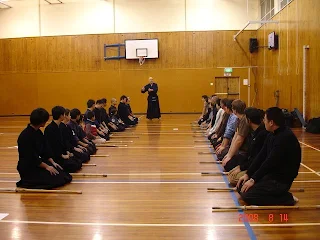
 Thanks to Robin P sharing his knowledge in the 2008 Beginner Class.
Thanks to Robin P sharing his knowledge in the 2008 Beginner Class. * * *
The Importance and Purpose of Etiquette in Kendo
- by Robin Parrington -
One of the first things newcomers notice when they watch a kendo practice is that there seems to be a lot of bowing.
We bow when entering the dojo, we bow to Shomen, we bow to Sensei and we bow to each other at the beginning and end of every rotation of partners.
To understand why we do this we have to consider the origins of Kendo. That origin is from the samurai of Japan.
The samurai were the military nobility and lived by their code of conduct known as Bushido or the way of the warrior. For the samurai good etiquette and proper behaviour were often a matter of life and death, for if he was to offend a superior or not show proper respect the consequences could be dire! Also, the conduct of samurai served as role model behaviour for the other social classes.
Over the years samurai developed Kendo as a safe way to practice their sword skills and it began to take its modern appearance during the late 18th century with the introduction of protective equipment: the men, kote and do and the use of the bamboo sword, the shinai. The use of the shinai and protective armour made possible the full delivery of blows without injury. This forced the establishment of new regulations and practice formats which set the foundation of modern Kendo … and for the samurai etiquette was an essential part of those regulations.
We are not and never will be samurai so you well may ask “why do we still need to use the samurai etiquette?” The answer is simple ... If we forget about these courtesies and manners then we aren’t practicing the martial art of the samurai called Kendo at all, we are just fighting with bamboo sticks. Just as etiquette was an essential part of samurai daily life, it was an essential part of his Kendo. It is as important to Kendo as our shinai or our bogu. Without proper etiquette there is no Kendo!
OK, so now we know why it is important to Kendo and you may ask “But what purpose does it serve?”
The answer to that is it serves the same purpose as in any civilized society. Consider, if, when walking along the street, perhaps in a hurry, someone is standing in your path, you shout angrily “Get out of my way! Move!” What the reaction you may receive? Compare that to the reaction you might get if you asked politely “Excuse me, May I pass please?” Both use the same number of words but the end results may be quite different.
I suspect that the first example could quite easily turn into a confrontational incident, where as the second example will most often result in the other person moving out of your way, giving you a smile and saying “Sorry”.
In Kendo we strike each other with a weapon, sometimes this may cause pain or discomfort. Correct etiquette and good manners help us to keep order, control our raw emotions and cultivate respect and humility.
Much of Kendo etiquette is quite easy to remember and is common sense. We should however try our best to execute all these courtesies to the best of our ability and not simply go through the motions or do them in a slap dash or haphazard manner, in that way we show respect to our teachers, our peers and to Kendo itself.
Kendo starts with Rei and Kendo ends with Rei!
Manners maketh man! They define your character.
Comments
In the same way in kendo, if you do not want to be polite, or if you do not care, you are losing a battle with yourself.